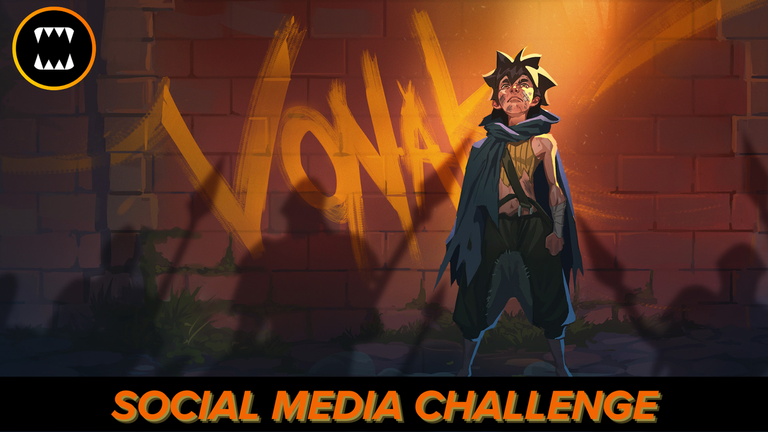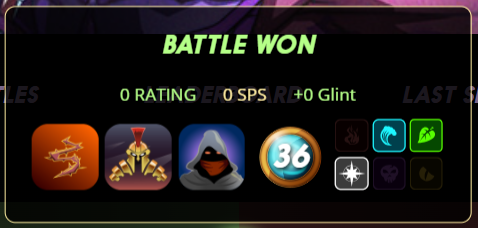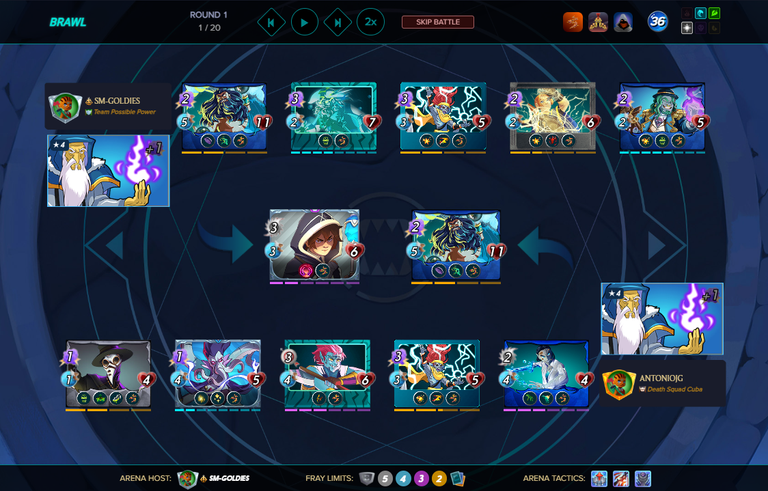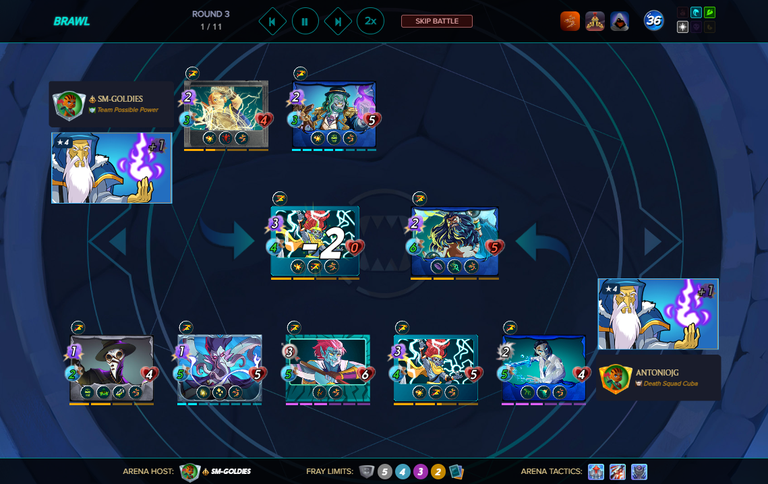
Español
¡Saludos comunidad! En el reto de esta semana quiero compartir con ustedes un análisis de mi experiencia utilizando una estrategia con el Splinter de Agua. La cual considero una excelente opción para aquellas partidas con un límite de maná medio y con la regla “Briar Patch”. Es importante recordar que el tipo de ofensiva a utilizar en nuestras estrategias también dependerá del resto de reglas presentes en la batalla.
En esta oportunidad, les explicaré cómo afronté una batalla de Brawl de la liga de Plata en el formato Salvaje, enfocando mi análisis en explicar cómo utilicé al Splinter de Agua, el invocador Alric Stormbringer y a las unidades Djinn Oshannus, Tide Biter, Ruler of the seas, Axemaster, Anasth Soothsayer y Doctor Blight para ser coherente con las reglas de batalla presentes y las habilidades que quería combinar con la finalidad de tomar ventaja en la partida con la estrategia planteada.
Ya que estos aspectos son un factor clave con un impacto considerable en el desempeño de nuestras estrategias.

Conjunto de reglas y elección

Hablemos sobre el conjunto de reglas presentes en la batalla, este es el punto de partida para iniciar el análisis que nos llevará a la elección más adecuada para afrontar la batalla.
Límite de maná igual a 36 puntos, esta cantidad nos permite elegir invocadores con un costo de maná entre 4 y 7 puntos. Sin embargo, es importante tener una estrategia definida para elegir a las unidades adecuadas con el maná restante.
Briar Patch es una regla que otorga la habilidad “Thorns” a todas las unidades. Por otra parte, Are You Not Entertained?, permite utilizar una unidad Gladius en la batalla. Mientras que, Silenced Summoners, elimina las habilidades, buffs y debuffs que otorgan los invocadores.
Entonces, tomando en cuenta todos estos aspectos, decidí utilizar al Splinter de Agua, ya que cuenta con unidades que poseen buenas estadísticas, entre ellas, un buen daño Mágico y Ranged. También cuenta con habilidades como: “Void”, “Phase”, “Reflection Shield”, “Reach”, “Swiftness”, “Blast”, “Double Strike”, “Cleanse”, “Tank Heal”, “Affliction”, “Poison”, entre otras, y con un invocador con un bajo coste de maná.

Equipo y estrategia

Hablemos sobre el equipo y la estrategia que conforma. Dadas las circunstancias, era evidente el uso de los ataques mágicos y ranged. Sin embargo, dadas las circunstancias, decidí elegir al invocador Alric Stormbringer, por su bajo coste de maná.
Djinn Oshannus actuó como tanque en esta oportunidad, ya que cuenta con buenas estadísticas, entre ellas, sus puntos de vida, velocidad y ataque mágico. También posee las habilidades “Void” y “Phase”, las cuales le permiten resistir mucho más los ataques mágicos.
Tide Biter es clave en la estrategia, ya que gracias a la habilidad “Reflection Shield”, evita que el resto del equipo pueda ser debilitado a través de la habilidad “Blast”. Además, también contribuye con su ataque melee desde la segunda posición.
Ruler of the Seas permite debilitar ambas líneas enemigas a través de la habilidad “Blast”. Además, otorga cierta ventaja al equipo, incrementando su velocidad en 1 punto mediante la habilidad “Swiftness”.
Axemaster ayuda a debilitar al enemigo de una forma considerable, ya que puede atacar 2 veces por turno mediante la habilidad “Double Strike”, lo cual se alinea de una forma excelente a su elevado daño ranged.
Anasth Soothsayer ofrece soporte al tanque mediante las habilidades “Cleanse” y “Tank Heal”, permitiéndole resistir mucho más los ataques enemigos.
Por último, Doctor Blight se encarga de otorgar cierta ventaja al equipo, una vez aplica sus habilidades “Poison” y “Affliction” al enemigo.

Estrategia en acción

Como les mencioné anteriormente, elegir al invocador Alric Stormbringer y a las unidades Djinn Oshannus, Tide Biter, Ruler of the seas, Axemaster, Anasth Soothsayer y Doctor Blight, fue una buena opción. Sin embargo, también es importante incluir habilidades de soporte que le permitan a nuestro tanque y al resto del equipo, resistir lo suficiente.
Observen como para el turno 1 de la ronda 3, el equipo enemigo estaba casi abatido. Djinn Oshannus se mantuvo firme en la primera posición, esto fue posible gracias al soporte de Anasth Soothsayer. Por otra parte, la contribución de Tide Biter, Ruler of the Seas, Axemaster y Doctor Blight fue clave para derrotar al enemigo.
Si quieres ver la batalla completa, acá te dejo el enlace: CLIC PARA VER LA BATALLA

Conclusión
La estrategia planteada hizo un uso eficiente de la cantidad de maná disponible, cubriendo aspectos tales como: resistencia contra el daño enemigo, soporte del equipo, una buena ofensiva, y coherencia con el conjunto de reglas presente.
Una debilidad de esta estrategia es un equipo enemigo que cuente con resistencia al daño mágico y ranged e incluya habilidades como: “Void”, “Void Armor”, “Phase”, “Tank Heal”, “Triage”, “Reflection Shield”, “Heal”, “Silence”, “Headwinds”, “Return Fire”, “Magic Reflect”, “Amplify”, entre otras.
La diferencia entre las estrategias fue que el equipo enemigo no contaba con el soporte suficiente para resistir los ataques de mi ofensiva.
Para el funcionamiento adecuado de nuestras estrategias, es importante considerar todos los aspectos involucrados, por lo que no sólo debemos enfocarnos en las estadísticas y habilidades a combinar. También debemos tener en cuenta la influencia de los conjuntos de reglas sobre la estrategia.
Este ha sido mi aporte al desafío semanal, ¡Espero haya sido de su agrado! ¡Saludos y hasta la próxima semana!

English
Greetings community! In this week's challenge I want to share with you an analysis of my experience using a strategy with the Water Splinter. I consider it an excellent option for those games with a medium mana limit and with the “Briar Patch” rule. It is important to remember that the type of offensive to use in our strategies will also depend on the rest of the rules present in the battle.
In this opportunity, I will explain how I faced a Silver League Brawl battle in the Wild format, focusing my analysis in explaining how I used the Water Splinter, the summoner Alric Stormbringer and the units Djinn Oshannus, Tide Biter, Ruler of the seas, Axemaster, Anasth Soothsayer and Doctor Blight to be coherent with the battle rules present and the abilities I wanted to combine in order to take advantage in the game with the strategy proposed.
Since these aspects are a key factor with a considerable impact on the performance of our strategies.

Rulesets and choise

Let's talk about the set of rules present in the battle, this is the starting point to begin the analysis that will lead us to the most appropriate choice to face the battle.
Mana limit equal to 36 points, this amount allows us to choose summoners with a mana cost between 4 and 7 points. However, it is important to have a defined strategy to choose the right units with the remaining mana.
Briar Patch is a rule that grants the ability “Thorns” to all units. On the other hand, Are You Not Entertained? allows you to use a Gladius unit in battle. While, Silenced Summoners, eliminates the abilities, buffs and debuffs granted by summoners.
So, taking all these aspects into account, I decided to use the Water Splinter, since it has units with good stats, including good Magic and Ranged damage. It also has abilities such as: “Void”, “Phase”, “Reflection Shield”, “Reach”, “Swiftness”, “Blast”, “Double Strike”, “Cleanse”, “Tank Heal”, “Affliction”, “Poison”, among others, and a summoner with a low mana cost.

Team and strategy

Let's talk about the equipment and the strategy it conforms. Given the circumstances, it was obvious to use magic and ranged attacks. However, given the circumstances, I decided to choose the summoner Alric Stormbringer, because of its low mana cost.
Djinn Oshannus acted as a tank in this opportunity, as he has good stats, among them, his life points, speed and magic attack. He also has the “Void” and “Phase” abilities, which allow him to resist magic attacks much more.
Tide Biter is key in the strategy, since thanks to the “Reflection Shield” ability, it prevents the rest of the team from being weakened through the “Blast” ability. In addition, he also contributes with his melee attack from the second position.
Ruler of the Seas allows to weaken both enemy lines through the “Blast” ability. In addition, it gives a certain advantage to the team, increasing its speed by 1 point through the “Swiftness” skill.
Axemaster helps to weaken the enemy in a considerable way, as he can attack 2 times per turn through the “Double Strike” ability, which aligns excellently with his high ranged damage.
Anasth Soothsayer offers tank support through the “Cleanse” and “Tank Heal” abilities, allowing him to resist enemy attacks much more.
Finally, Doctor Blight gives the team a certain advantage once he applies his “Poison” and “Affliction” abilities to the enemy.

Rule in action

As I mentioned before, choosing the summoner Alric Stormbringer and the units Djinn Oshannus, Tide Biter, Ruler of the seas, Axemaster, Anasth Soothsayer and Doctor Blight was a good choice. However, it is also important to include support abilities that allow our tank and the rest of the team to resist enough.
Notice how by turn 1 of round 3, the enemy team was almost down. Djinn Oshannus held firm in the first position, this was possible thanks to the support of Anasth Soothsayer. On the other hand, the contribution of Tide Biter, Ruler of the Seas, Axemaster and Doctor Blight was key to defeat the enemy.
If you want to see the complete battle, here you have the link: CLICK TO WATCH THE BATTLE

Conclusion
The strategy proposed made efficient use of the amount of mana available, covering aspects such as: resistance against enemy damage, team support, good offense, and coherence with the present rule set.
A weakness of this strategy is an enemy team that has resistance to magic and ranged damage and includes abilities such as: “Void”, “Void Armor”, “Phase”, “Tank Heal”, “Triage”, “Reflection Shield”, “Heal”, “Silence”, “Headwinds”, “Return Fire”, “Magic Reflect”, “Amplify”, among others.
The difference between the strategies was that the enemy team did not have enough support to resist my offensive attacks.
For the proper functioning of our strategies, it is important to consider all the aspects involved, so we should not only focus on the statistics and skills to combine. We must also take into account the influence of the rule sets on the strategy.
This has been my contribution to the weekly challenge, I hope you enjoyed it! Greetings and see you next week!

Te invito a seguirme en / I invite you to follow me on: Twitter
Las traducciones fueron realizadas con el traductor / Translations were done with the translator: DeepL
Todas las imágenes fueron tomadas de / and all images were taken from: Splinterlands

The rewards earned on this comment will go directly to the people( @antoniojg ) sharing the post on Reddit as long as they are registered with @poshtoken. Sign up at https://hiveposh.com. Otherwise, rewards go to the author of the blog post.
¡Felicitaciones!
1. Invierte en el PROYECTO ENTROPÍA y recibe ganancias semanalmente. Entra aquí para más información.
3. Suscríbete a nuestra COMUNIDADEntra aquí para más información sobre nuestro trail., apoya al trail de @Entropia y así podrás ganar recompensas de curación de forma automática.
4. Creación de cuentas nuevas de Hive aquí.
5. Visita nuestro canal de Youtube.
Atentamente
El equipo de curación del PROYECTO ENTROPÍA
Congratulations @antoniojg! You have completed the following achievement on the Hive blockchain And have been rewarded with New badge(s)
Your next target is to reach 40000 upvotes.
You can view your badges on your board and compare yourself to others in the Ranking
If you no longer want to receive notifications, reply to this comment with the word
STOPCheck out our last posts: